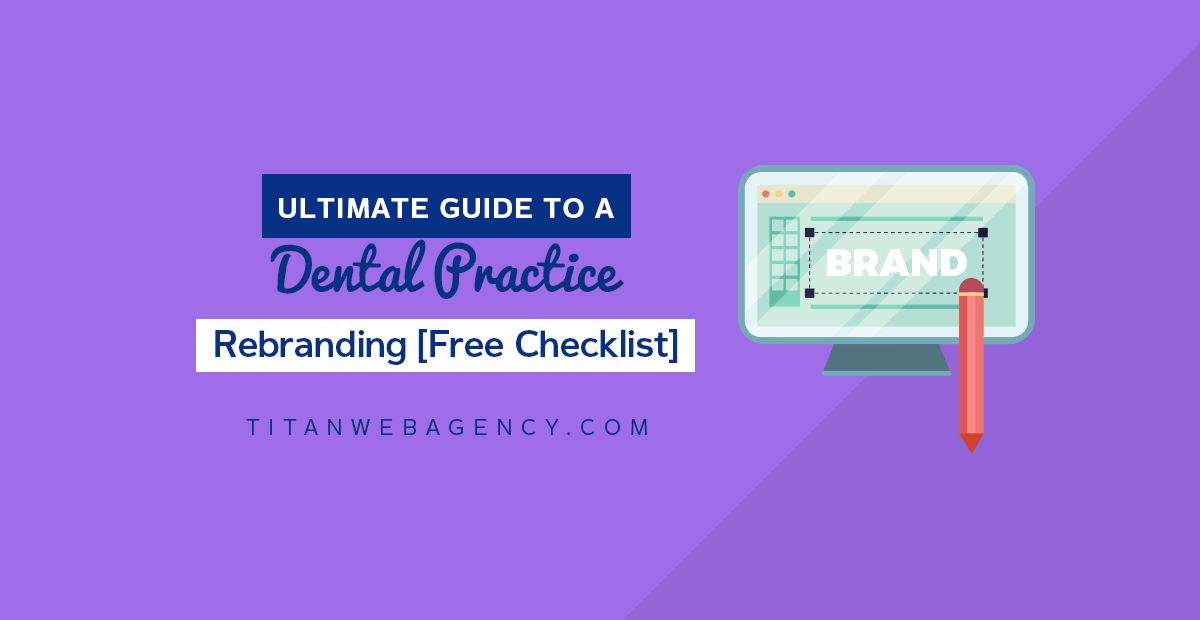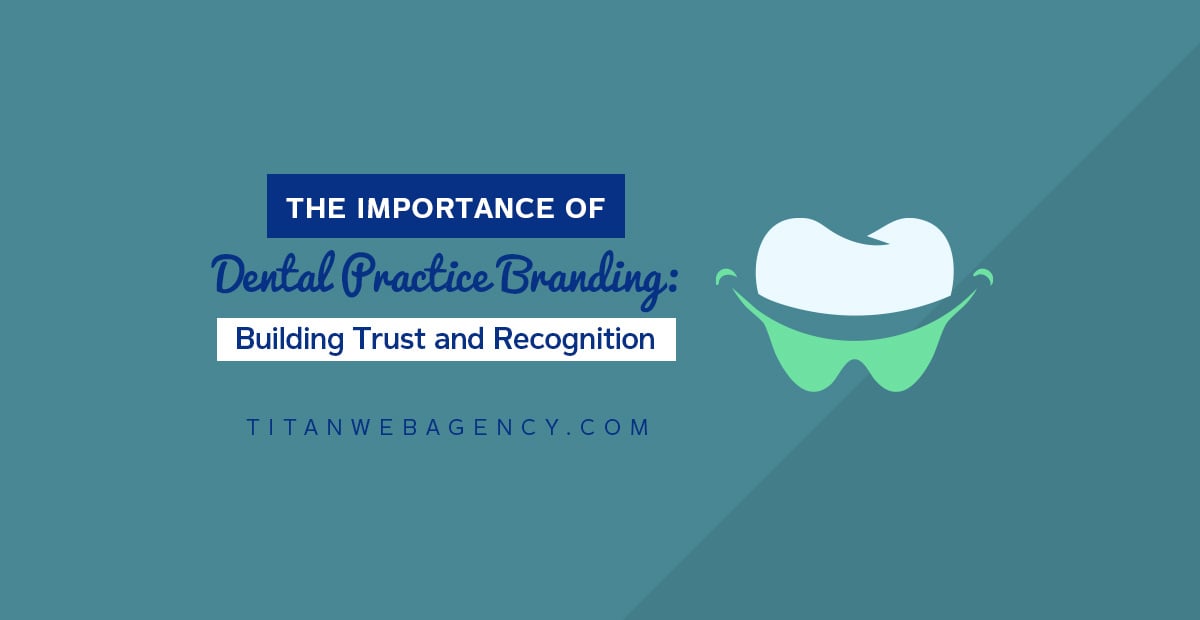(This post was originally published March 24, 2016, and updated December 20, 2025.)
When it comes to marketing strategies, building a strong dental brand is a key topic. Nearly every dental office brand can benefit from a little improvement, but rebranding your practice is a big decision. It involves taking a step back and reconsidering everything about how your practice is presented to potential patients.
Key Takeaways
- Rebranding a dental practice involves more than a logo change and includes messaging, website updates, and consistency across all patient touchpoints.
- Practices should consider rebranding when their brand feels outdated, ownership or services change, or the current image no longer reflects the patient experience.
- A rebrand does not always require changing the practice name, and name changes should only be made for clear strategic or legal reasons due to SEO and recognition risks.
- The cost of rebranding varies widely depending on scope, including whether it involves visual updates only or also a new website, signage, and marketing assets.
- One of the most common rebranding mistakes is inconsistency, especially failing to update online listings, directories, and marketing materials at the same time.
- Successful rebranding requires a clear plan, realistic timeline, and defined vision before design work begins.
- Communicating clearly with patients during a rebrand helps preserve trust and prevents confusion.
- A well-executed rebrand improves clarity, strengthens recognition, and supports future marketing efforts.
At Titan Web Agency, we help dental practices fine-tune their branding regularly. Without proper branding, the best marketing efforts may be in vain. For that reason, we have created this guide to help you decide if rebranding your practice is right for you and what to do if it is. If you are branding your dental office and trying to build your reputation, there's still much you can learn from this blog post.
What is Dental Practice Rebranding?
Let's start with the basics. What is dental practice rebranding, and what goes into it? Rebranding involves rethinking every aspect of how your practice is presented to the public.
Typically, a full rebrand includes a new logo, color scheme, business signage, letterhead, and business cards, and may also involve a new business name. It will also include new digital branding. You will need a new website design, profile pictures, cover photos, bios for your social media profiles, a new email newsletter design, and more.
As you can imagine, this shouldn't be taken lightly.
We have worked with several dentists who have undergone full rebrands after purchasing an office from another dentist and want to change the dental practice name to include their own name or an entirely new one. It is a task that must be undertaken with precision and an understanding of how your new brand will affect your ability to attract prospective patients.

8 Reasons Why You May Need to Rebrand Your Dental Practice
There are many reasons why you might want to rebrand your dental practice. Here are 8 for you to consider.
1. Your Practice Has Expanded
Perhaps when you bought your practice, you had just a couple of chairs and did primarily preventative work. You now have a half-dozen chairs, and you do a lot of restorative and cosmetic dentistry in addition to your initial preventive work.
You don’t want your old branding to limit the scope of what you have to offer.
The same is true if your practice has expanded beyond your geographical area. If your practice name was specific to a city but you have expanded into a neighboring city, you may want to consider an updated name and either a full or partial rebrand.
2. A Merger or Acquisition
If you have merged or acquired another dental practice, rebranding is usually recommended. We often see, after a merger, a new brand formed by combining the two practices’ names to help retain existing customers' loyalty. However, combining the names isn't typically the best approach. You'll likely want to consider creating a new name and notifying all existing patients of the change.
3. Legal Issues
Legal issues can arise unexpectedly and necessitate rebranding. The most common issue is having a brand name, logo, or slogan that is too similar to a trademarked company. Even if you have been using the logo or name for years, it might not be worth taking the case to court and paying legal fees.
4. Negative Publicity
It is unlikely that your practice has been associated with a corporate collapse or crime, but if your dental practice's reputation is not healthy, you will need to do some repair work. In many cases, it will be possible, and preferable, to repair your brand without rebranding. Simply renaming the company and coming out with a new logo and dental website is a shady way to get out from under negative publicity.
Sometimes, your brand can end up being associated with something you have no control over and have nothing to do with, yet it can still spark negative thoughts and emotions in your customers.
A good example of this is the sports drink Tsunami, which had to rebrand in 2005 after a giant tsunami killed hundreds of thousands in Indonesia.

If you have a publicity problem beyond your control, rebranding can be an effective way to reinvent yourself.
5. Out-of-Date Brand Image
If you bought a practice that has been in business for decades, or you yourself have been in business for a long time, your brand may have become dated. The public's response to and expectations of branding have evolved, and you may need to update your brand to stay in step with the times.
6. Need for Differentiation
Is your practice getting lost in the crowd? If your practice is in an area with many competitors, rebranding will improve your visibility and help potential patients understand why they should choose you as their dentist.
7. Loss of Relevancy
For any brand to be successful, it must be relevant to its target audience. If your branding isn't resonating with the patients you want to attract, it may be time to rebrand to make your practice relevant again.
8. Struggling to Attract New Patients
Stagnant patient lists are among the most common problems we face as dental marketing experts. It is easy to assume that because you provide quality dental care, patients will come, but that is not always the case. New branding can help inspire your current patients to refer their friends and family and attract new patients through creative dental marketing.
Cost of Rebranding a Dental Practice
One of the rebranding questions we hear the most is this:
How much does it cost to rebrand a dental practice?
That is an important question because you cannot undergo the rebranding process without the budget to support it.
Costs can vary depending on the size of your practice. For example, it will cost more to rebrand a practice with multiple locations than it will to rebrand a stand-alone practice. As a rule of thumb, you should expect to spend between 10% and 20% of your marketing budget on rebranding.
For example, if your marketing budget is $100,000, your rebranding will likely cost between $10,000 and $20,000.
Our current price for a custom logo is $1,199, and for a logo and style guide (includes letterhead and business card design), it is $1,999. After this, if you are a monthly marketing client, we handle everything else for you; that alone is an estimated value of $ 4,000 (updating an existing website, updating your online directories, writing and issuing a press release, etc.).
At Titan Web Agency, we can help you with every aspect of rebranding, including:
- New practice name suggestions
- Creating a new logo, colors, style guide, etc.
- New website URL (domain name) suggestions
- Creation of a new website or updating an existing site to match the new brand
- Updating existing online properties such as Facebook, Google, Healthgrades, and more (as part of an ongoing dental SEO campaign or a one-time update)
- Press release written and distributed (helpful with AI Optimization and improving your mentions in the AI results).
Titan Web Agency specializes in helping dentists rebrand or build a brand for their practice at an affordable price that the big branding agencies don't offer.
Usually, before securing a loan or financing to buy a practice, you'll want to consider the potential cost of a rebrand, as rebrands are often complicated, expensive, and necessary.
Mistakes to Avoid When Rebranding Your Dental Practice
As you might imagine, the road to rebranding your practice is paved with potential roadblocks and pitfalls. It is important to avoid these if you can.

Changing Your Name for No Good Reason
Rebranding may include a name change, but should be done only if necessary. Any negative publicity beyond your control, or the merging with another practice, may require a name change. You should keep in mind that changing your practice name frivolously means you will be giving up any name recognition you have acquired. In most cases, rebranding involves keeping the same name and changing the branding around it.
Sacrificing Simplicity to Appear More Interesting
Good branding is simple. It needs to be easily understood, conveying the most essential information and values of your practice as quickly and clearly as possible. Dental rebranding efforts sometimes fail because the new brand sacrifices simplicity. You should focus on how your new brand will be perceived and make it as clean and uncomplicated as you can.
No Concrete Plan and Timeline
There's no denying that rebranding is a big undertaking, and predicting how long it will take can be difficult. That said, it is essential to make a concrete rebranding plan and create a timeline for each element. If you don't, you may end up with unclear messaging that confuses your audience and negatively impacts your practice.
Not Having a Brand Style Guide
A big part of effective branding is consistency. If you don't pay attention to the details, potential patients may not recognize your brand. That means letting your brand colors, typography, and iconography dictate the design of your website, printed marketing materials, social media posts, and even your office. Having a brand style guide will help you make the rebranding successful.
Not Doing Your Name Research
You may have a name in mind, but it is essential to use Google and your favorite LLM tool to search for names. You may love a name, but it's important to know what type of reputation (if any) is associated online with that name.
How to Rebrand Your Dental Practice: Best Practices
Now that you have decided that rebranding is the right choice for your practice, you are ready to get started. To help you do a good job with the dental branding process, here are some best practices to follow.
Hire a Rebranding Team
The first step is to hire a rebranding team to help you. While you know your brand, most dental professionals are focused on oral health, not marketing. That means you need assistance from a knowledgeable company to help you identify key differentiators between you and your competitors and create branding that will help you achieve your goals.
Understand What it Takes
If you have decided that rebranding is worthwhile for your practice, the next step is to determine how much of an undertaking it really is.
Your company's rebranding will require much more effort than designing a new logo and updating your stationery. You will also need to update your signage and website. You can’t cut corners on this. Research indicates that 60% of US Millennials expect their brand experience to be consistent across online, in-store, and phone channels.
If you are changing the name of your practice, you will need to purchase a new domain name and update all your social media profiles with your new graphics and brand name.
It is also essential to update your local business listings (Yelp, HealthGrades, Google Business Profile, Facebook, etc.) and wherever else your business may appear if you want to remain relevant in Google Local search.
At the same time, rebranding a business comes with certain downsides. We have already mentioned the cost, so you know you will need to be prepared to invest some money in rebranding.
After everything's said and done, it may have cost you tens of thousands of dollars- not to mention the value of your time investment.
If your rebranding involves a name change, you will lose any name recognition you had, and you may lose some customers in your push to appeal to new ones. You may also experience a decrease in your organic search results at first. There are some best practices you can follow to minimize the effects.
In short, it’s important to understand the scope of rebranding before you dive in.
Have Your Vision in Mind
When developing your branding strategy, it is easy to get caught up in the details, such as brand colors and dental logo design. These are important steps, but they are not the first steps to rebranding a company.
Before you start the process, evaluate your practice’s current strengths and weaknesses. Rebranding is an effort to solve a problem with your existing messaging. So, what exactly is that problem?
You may want to survey existing patients to find out. If you already know what problems your current branding has, it is essential to focus on what you want your branding to do and keep that idea at the heart of every rebranding decision.
Collaborate with Your Team
Any experienced rebranding team will work closely with you to develop your new brand and everything associated with it, from your logo to appointment reminder cards to signage.
Remember to communicate your priorities and view the entire process as collaborative. Keep an open mind and don't be afraid of innovative ideas. Remember, hiring a professional team gives you access to specialized experience and expertise that you don't have.
Talk to People
You probably have some idea of what’s wrong with your current brand, but it is more important to know what others think.
Spend some time reaching out to your current patients, employees, or even experts in the healthcare industry to get their opinions about your dental practice’s brand and services. A clever way to get your employees excited about rebranding is to involve them as active participants.
If you can get people to be honest with you and paint a clear picture of what they do and don’t like, this valuable information can help you achieve your overall goals.
You should have a good idea of the core messaging you want after you rebrand and a clear understanding of how it will solve your current branding problem.
Consider Your Competition
The best way to understand where you stand in your local market is by comparing yourself to the competition’s marketing strategy. Spend some time researching your direct and indirect competitors in your market. Answer the following questions:
- What is their brand message?
- What are their overall attributes?
- How do they bring value to their customers?
Answering these questions will help you determine where you are currently positioned in the market and brainstorm ideas to stand out from your competitors during your dental practice rebrand.
Consider Your Own Interests
Rebranding is the perfect opportunity to align with your interests and attract the kind of patients you want. Of course, you will want to focus on what prospective patients want, but it's also essential to think about what you want.
Which aspect of your job brings you the most joy? For example, you might prefer certain procedures over others, or you might love working with young children.
Use your rebranding as an opportunity to specialize in the dental services you want to provide, in the way you want to provide them.
Consider Psychology of Colors
When redesigning a logo, choosing the right colors is one of the most important branding decisions for any business. Color increases brand recognition by 80% (vs. monochrome) and directly affects consumer confidence.

For dentists (and all healthcare providers, really), it is essential to choose colors that convey a message of responsibility and trust to potential patients.
In general, “cooler” colors such as white, blue, and green tend to suggest stability, trust, and calm. These are all valuable feelings to convey to your target audience.
Rethink Your Target Customers
Most brands have a very narrow view of who is in their target audience. That may be true for you. It may also be true that the demographics of your audience when you first started your practice are no longer the same. Rebranding is the perfect opportunity to reevaluate your target customers and develop a digital marketing strategy that resonates with them.
The specialties of your practice may dictate your audience. If your target persona is over 65, it would be worthwhile to continue catering to Baby Boomers and Generation X.
According to the latest figures, only 61% of Americans aged 18 to 44 visited a dentist in the previous year. That incorporates all Millennials, and attracting their business (and that of Generations Y and Z) can help you grow your practice.
There is a ton of data out there on how different demographic groups respond to brand messaging and what they expect from a business. Consider this when developing your branding strategy.
Communicate Clearly and Consistently
Any marketer will tell you that your new brand needs to be publicized. To maximize the value of your current client base and ensure they remain loyal, you need to think creatively. This involves establishing a consistent brand voice and applying it consistently across all platforms, including your website, social media, and printed marketing materials.
For example, many dentists prefer a tone that is both warm and professional. You want patients to believe you have the training and confidence to provide quality dental care, along with the compassion to help them feel good about their smile.
Tell a Story
You know why you decided to rebrand your practice, but your patients don't. You need to share your story with them to help them understand and get on board with the changes.
The most important thing is to tell a story that puts the changes in a positive light and reassures your current clients of your continued commitment to meeting their needs. If you don't, they may write their own story about the rebranding, which may not be in your best interest.
Get creative in your email marketing by writing a personal message or creating a video to tell the rebranding story. Let your customers know the rebrand is happening in advance and keep them up to date on its progress so they feel involved in the evolution.
Another great dental retention strategy is to feature some of your current patients as case studies or reviews on the rebranded practice’s website. This will offer reassurance that you are still the same business.
Consider Client Touch Points
When it comes to attracting new patients with your rebrand, you need to consider how your practice is perceived at every touchpoint. Communication is a touch-point for which you may want to develop a new strategy.
Consider these statistics if you are trying to draw in Millennials:
This is valuable information to know when considering client touchpoints. According to research, pay-per-click advertising doesn't work as well with the Millennials demographic because they indicate they don't like to be advertised to, but social media marketing does. Keep in mind, this isn't 100% of the time. You'll want to test out different strategies. It may be that in your area, pay-per-click advertising DOES work for Millennials. Test it.
Set a Realistic Timeline
We talked about being prepared for the realities of rebranding. Part of that is understanding how long it will take and creating a timeline to achieve your rebranding goals.
Rebranding your dental practice may take as little as 6 months or as long as 1 year. Your rebranding team can help you manage your expectations and create a timeline with due dates for each deliverable, including your new logo, web design, and business cards.Track the Success of Your Rebrand Effort
The final element of a successful rebranding is tracking your results. Working with an expert team will minimize the risk that your new brand won't resonate with your audience, but you may still need to fine-tune your branding package. You will need to monitor your results and tweak them as needed to reap the full benefits of branding.
You should monitor the following things to track your rebranding:
- Website analytics
- PPC ad results
- Organic search
- Social media statistics (follows and shares)
- Reviews
If you notice your rebranding isn't delivering the results you want, you can make any necessary changes to keep your branding memorable.
Now for the ever-important frequently asked questions.
Dental Practice Rebranding Frequently Asked Questions
What does rebranding a dental practice involve?
Rebranding a dental practice involves updating its visual identity, messaging, website, and marketing materials to better the practice today and how it wants to be perceived by patients.
When should a dental practice consider rebranding?
A dental practice should consider rebranding when its branding feels outdated, the practice has grown or changed, ownership has changed, or the current brand no longer matches the patient experience.
How much does it cost to rebrand a dental practice?
The cost to rebrand a dental practice varies widely depending on the scope, such as whether the rebrand includes only visual updates or also a new website, signage, and marketing assets. Titan Web Agency offers very affordable pricing for practice rebranding. We can customize each rebranding package to your specific needs, so you aren't paying for more than you need. Our current price for a custom logo is $1,199, and for a logo and style guide (includes letterhead and business card design), it is $1,999. After this, if you are a monthly marketing client, we handle everything else for you; that alone is an estimated value of $ 4,000 (updating an existing website, updating your online directories, writing and issuing a press release, etc.).
Is changing a dental practice name required when rebranding?
No, rebranding does not always require a name change, and changing a practice name should be done only for clear strategic or legal reasons, given its impact on recognition and SEO.
What are common mistakes dentists make when rebranding?
Common rebranding mistakes include changing too much at once, failing to update online listings consistently, and focusing on appearance instead of clarity and patient trust.
Ready to Start Your Dental Practice Rebrand?
Rebranding your dental practice is an effective way to differentiate yourself from competitors, attract new patients, and gain a competitive edge. The guidelines we have included here will help you have a successful rebranding that ticks all the boxes.
Are you ready to create a new brand that will attract new patients by assuring them of the high level of care they'll receive at your practice? Titan Web Agency is here to help.
Do you need help with your rebranding?
Schedule a FREE dental marketing consultation!
Book a consultation now. No pressure, no selling, just a consultation with somebody who’s been in dental marketing for nearly 15 years and knows what works.
Recommended Reading
- The Ultimate Guide to Buying a Dental Practice
- Starting a Dental Practice: A Complete Step-by-Step Guide
- Dental Practice Transitions: A Guide for Successful Dental Office Transitions
- Dental Office Names: How to Name Your Dental Practice
- Tax Considerations When Selling a Dental Practice
- Relocating Your Dental Practice? Here's Your Step-by-Step Plan [Free Checklist]
- Dental Practice Valuation: A Guide for Dentists
Tyson Downs is the founder of Titan Web Agency, a company specializing in marketing for dental professionals. With an impressive track record of working with over 100 dental practices, Tyson has a deep understanding of the unique marketing needs within the dental industry.











.png)
.png)


